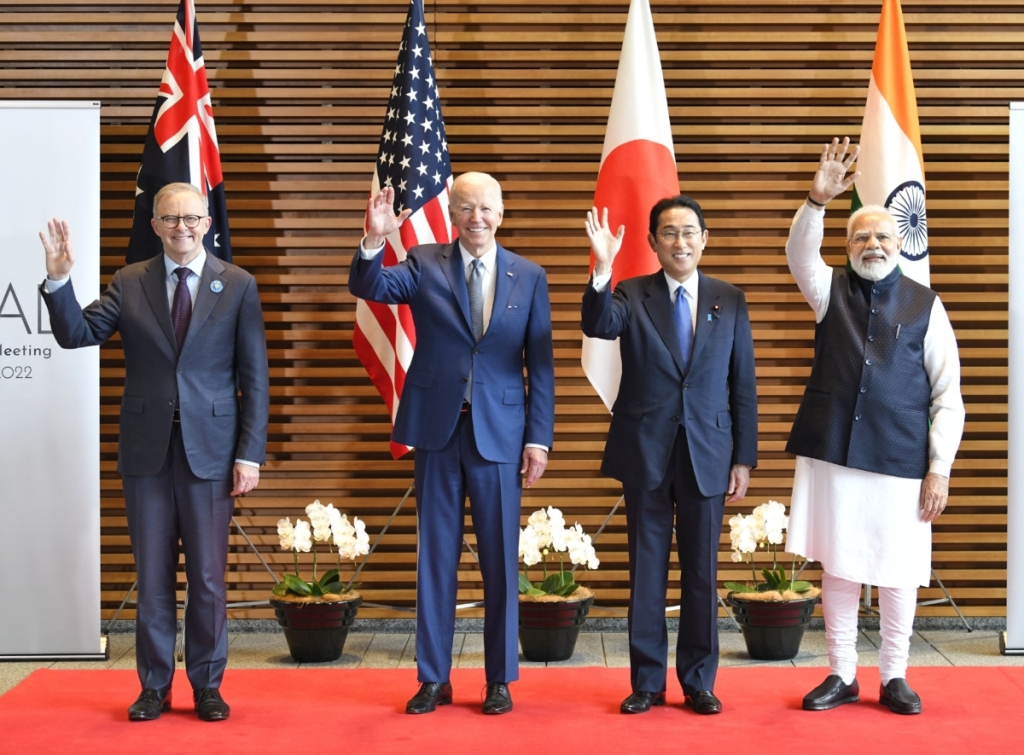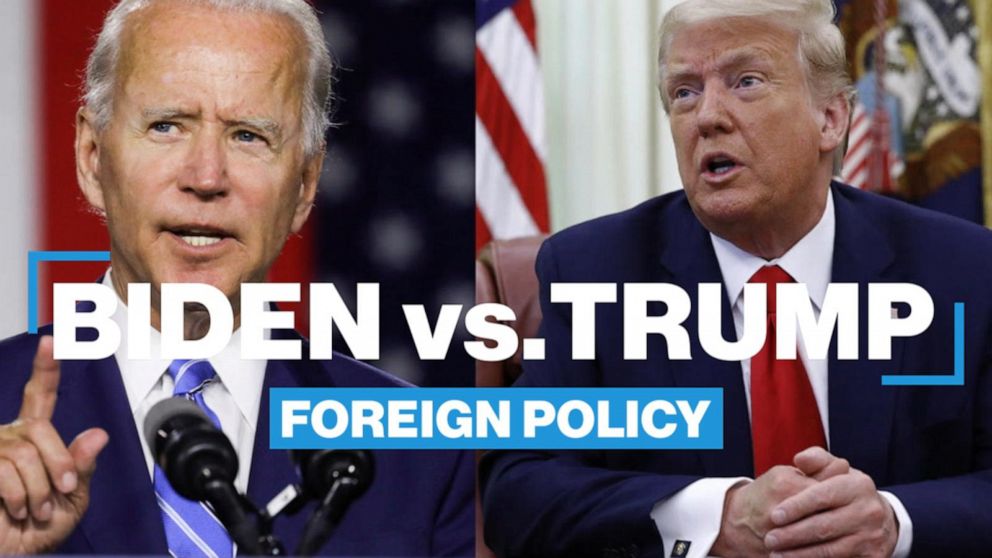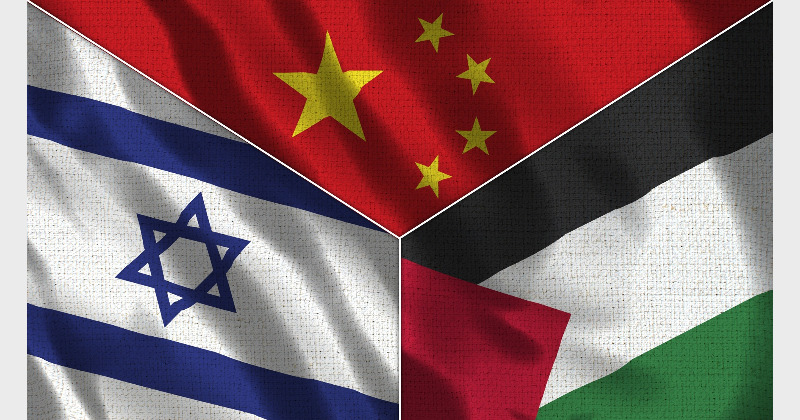Listen to the article
China-India relations play out against the background of their relations with other powers. Beijing is watching India’s growing involvement in the Quadrilateral Security Dialogue (Quad). And India keeps a close eye on China’s relations with its South Asian neighbours (especially Pakistan) and Russia.
The May 2022 Quad summit in Tokyo is therefore important from the perspective of China-India relations. The summit was significant for several reasons.
First, it demonstrated continuity in agenda by the four partners—Japan, Australia, India and the United States—despite changes in political leadership (in Japan and Australia), the COVID-19 pandemic, and differences on Russia’s invasion of Ukraine (as indicated in the Tokyo 2022 Quad Leaders’ Summit Joint Statement).
Second, it established both normative and practical initiatives to expand stakeholder buy-in, while at the same time ensuring that it remained as exclusive a group as possible. Here, the focus on peace and stability and stressing the use of the United Nations as a forum for resolving conflict was material in the mini-lateral’s preference for dealing with international disputes through the UN Charter.
This recognition obliquely criticised Russia’s aggression against Ukraine but also China’s position on the invasion which violates China’s Five Principles of Peaceful Co-existence, including the principles of mutual respect for sovereignty, territorial integrity, and mutual non-aggression.
Third, the Quad’s practical initiatives with regards to COVID-19 and global health, security, infrastructure, climate change, cybersecurity, critical and emerging technologies, space, maritime domain awareness and humanitarian assistance and disaster relief (HADR) are all meaningful initiatives to strengthen partnerships moving forward.
These initiatives expand areas of cooperation based on comparative advantages, emerging needs, and convergence in how the organisation can continue to move forward at different speeds in different areas.
In terms of the normative aspect of the Quad, it was important that the four leaders talked about peace and stability not only within the region but also in extra-regional areas.
Concerns about Russia’s invasion of Ukraine, its implications for food security, energy security, and the overt challenge to the existing rules-based order which prioritises utilizing the United Nations as the vehicle to resolve international conflict was important in terms of the four countries demonstrating cohesiveness on global order.
Here, critics will argue that the four countries are diverging in terms of their understanding of a rules-based order, especially when it comes to Russia. Castigators aside, we should understand India’s position, as Ashley Tellis argues, from the viewpoint of energy security and hard security.
Today, according to security commentator Adnan Ahmad Ansari, Delhi still needs to acquire Russian made weapon systems in order to deal with its conflict along the Himalayan border with China given the challenges facing India’s self-reliance campaign.
Abstaining from the UN vote did not mean that India accepted the use of force against Ukraine. Rather, it was also abstaining for a practical purpose, i.e., to ensure that its economy could continue to grow and climb out of the COVID-19 pandemic challenges with access to cheap energy imports.
The Quad’s concrete initiatives with regards to COVID-19 and global security are clear evidence of a shift towards public goods provision being another pillar of the mini-lateral. Partners agreed to commit over US$ 5.2 billion to the COVAX Advance Market Commitment (AMC) mechanism.
This is important for the provision of COVID-19 vaccines to the emerging world that has left been left largely ignored or under-resourced, not just in terms of vaccines but also financial aid to help recovery from the pandemic.
The commitment of assistance towards infrastructure, cybersecurity, critical and emerging technologies overlap. It is clear that the best way to build inter-regional norms, institutions and a rules-based order is to connect stakeholders throughout the Indo-Pacific. This will require connecting the region through digital connectivity, clean energy, and resilience programs.
The initiatives will be welcomed in Southeast Asia and South Asia as will placing ASEAN at the center of the Quad’s Indo-Pacific stakeholder outreach. As noted in the Quad Joint Leaders’ Statement:
“We reaffirm our unwavering support for ASEAN unity and centrality and for the practical implementation of ASEAN Outlook on the Indo-Pacific.”
This explicit recognition of ASEAN centrality resonates with the ASEAN Indo-Pacific Outlook but will help expand the number of stakeholders as well.
The emphasis on cybersecurity and critical and emerging technologies is twofold. Cybersecurity has become an increasingly critical domain of security as ransomware issues, and the distribution of disinformation has created challenges towards sustainable governance and fomenting mistrust between governments.
Critical and emerging technologies are those dual-use technologies that are a challenge to security within the region. Here the common statement and principles on critical technology supply chains will build more resilience into technology supply chains and likely accelerate the bifurcation of technology supply chains from one that is based on like-minded countries, such as the Quad partners, and the other that is based on China and its BRI partners that may or may not include Russia.
Space and maritime domain awareness as well as HADR are also critical areas that the Quad discussed. Space and maritime domain awareness go hand in hand. The availability of 35,000-foot macro views of the region’s maritime environment and submarine environment are critical to enhancing security throughout the region by identifying missile launchers, ship distribution, and submarine resources that can be used as in deterrence but also to attack countries within the region.
Moreover, satellite and other forms of maritime and terrestrial domain awareness technologies are critical for observing whether countries are amassing the essential resources for an invasion.
Critical to the Indo-Pacific region is China’s long-term ambition to re-unify with Taiwan. Quad partner cooperation in the area of full spectrum domain awareness will be crucial to detect the concentrating of military resources to forcefully reunify with Taiwan.
The Quad members acknowledged humanitarian assistance and disaster relief (HADR) to be a challenge moving forward as non-traditional security issues continue to multiply both in number and severity.
The COVID-19 pandemic is the most recent example, but we should understand that natural disasters such as earthquakes, tsunami and large-scale hurricanes also have the potential to fundamentally destabilise Southeast Asia and South Asia which are both home to large populations and centers of food production for their communities and the regional community.
The Quad moving forward will continue to invest in public goods provision throughout the region. It will continue to be a mini-lateral organisation that will be loosely institutionalized, pragmatic in its focus, and open to functional cooperation on an ad-hoc basis, both in terms of its number of partners as well as the focus of cooperation.
Evidence of this functional cooperation on an ad-hoc basis has already occurred in January 2021 with Canada participating in the Sea Dragon 21 maritime exercises near Guam and the Quad joining the Perouse exercises in April 2021 alongside France.
Concerns about an Indo-Pacific NATO emerging in the region built on the skeleton of the Quad as articulated by State Councilor and Foreign Minister Wang Yi are a straw man argument. The Indo-Pacific region is too heterogenous in terms of development levels, political systems, and ties with China for an Indo-Pacific NATO. Instead, the Quad will be a mini-lateral problem-solving group that bridges security and public goods provision.
This artcile was first published on June 17, 2022, at https://lkyspp.nus.edu.sg/cag/publications/center-publications/publication-article/detail/quad-as-problem-solver-or-security-mini-lateral-bridging-security-and-public-goods-provision.





Leave a comment